Want to improve your facial aesthetics and overall oral health? The "Mewing" technique, combined with proper breathing, might be the answer. This comprehensive guide will walk you through the basics of mewing and breathing correctly, highlighting the benefits and potential drawbacks.
What is Mewing?
Mewing is a technique that involves consciously repositioning your tongue on the roof of your mouth. Instead of resting your tongue on the bottom of your mouth, you should press it gently against the palate, from the back of your upper teeth to the uvula. This seemingly simple change is believed to influence the development and shape of your facial structure over time.
Benefits of Mewing:
- Improved Facial Aesthetics: Many proponents claim mewing can lead to a more defined jawline, stronger chin, and improved facial symmetry. These results are not guaranteed and require consistent effort over a long period.
- Better Posture: Proper tongue posture can contribute to better head and neck posture, potentially relieving tension and headaches.
- Improved Breathing: Correct tongue placement can open up nasal passages, facilitating better nasal breathing.
- Enhanced Oral Health: Maintaining proper tongue posture can improve oral health by promoting better swallowing patterns and reducing the risk of teeth misalignment.
How to Mew Correctly:
- Tongue Placement: Gently press your tongue against the roof of your mouth, ensuring full contact from your upper teeth to your soft palate.
- Soft Palate Elevation: Try to elevate your soft palate. This often happens naturally as you correctly position your tongue.
- Gentle Pressure: Avoid excessive pressure; it should feel comfortable and natural.
- Consistency is Key: The effectiveness of mewing relies on consistent practice throughout the day. Start with short intervals and gradually increase the duration.
- Professional Guidance: Consider consulting an orthodontist or dentist for personalized advice, especially if you have existing dental issues.
The Importance of Proper Breathing
Breathing correctly is crucial, and often overlooked, in achieving the full benefits of mewing. Nasal breathing, as opposed to mouth breathing, is essential for optimal facial development and overall health.
Benefits of Nasal Breathing:
- Improved Oxygen Intake: Nasal breathing filters, warms, and humidifies the air, ensuring better oxygen absorption.
- Better Sleep Quality: Nasal breathing contributes to better sleep quality by promoting deeper, more restful sleep.
- Reduced Risk of Infections: Nasal breathing filters out pollutants and pathogens, reducing the risk of respiratory infections.
- Enhanced Facial Development: Nasal breathing helps maintain proper pressure within the oral cavity, contributing to optimal facial growth.
How to Breathe Properly:
- Breathe Through Your Nose: Make a conscious effort to breathe primarily through your nose.
- Diaphragmatic Breathing: Practice diaphragmatic breathing (belly breathing) to maximize lung capacity and oxygen intake.
- Minimize Mouth Breathing: Avoid mouth breathing as much as possible, especially during sleep. Consider using a nasal strip if necessary.
- Relax Your Jaw: Keep your jaw relaxed and slightly forward, allowing for unobstructed nasal breathing.
Potential Drawbacks and Considerations
While mewing and nasal breathing offer several potential benefits, it's crucial to acknowledge potential drawbacks:
- No Guaranteed Results: The effectiveness of mewing varies significantly among individuals. Results may not be visible for many months or years of consistent effort.
- Potential Discomfort: Initially, maintaining proper tongue posture may feel unnatural or uncomfortable. Gradually increase the duration to avoid discomfort.
- Not a Replacement for Orthodontic Treatment: Mewing is not a substitute for orthodontic treatment. Consult a professional for any significant dental issues.
Conclusion
Mewing and proper breathing are techniques that, when practiced consistently, may contribute to improved facial structure, better posture, enhanced oral health, and overall well-being. Remember to practice consistently, maintain a healthy lifestyle, and seek professional guidance when necessary. The journey to improved facial aesthetics and health is a marathon, not a sprint.
